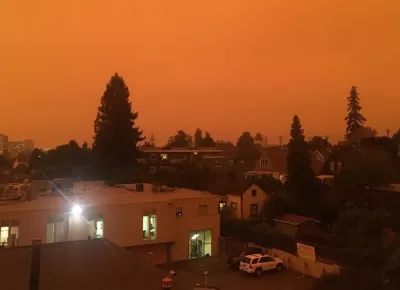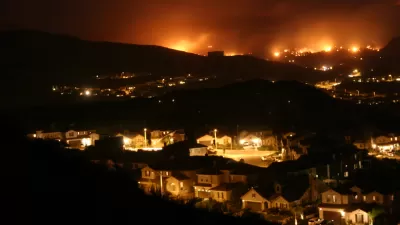Home insurers argue they should be able to base policy costs on modeling that accounts for future risks from climate change and overdevelopment.

The home insurance industry is calling on California to discourage construction in fire-prone zones by allowing insurers to account for future risks when evaluating policy applications. With climate change causing more extreme wildfire seasons and development pushing farther into high-risk areas, reports Debra Kahn, California insurers anticipate increasingly severe damage from wildfires. Meanwhile, homeowners in fire zones are finding it more difficult to secure policies or seeing their rates rise dramatically, even through the state's last-resort option, the FAIR plan. In October, the state temporarily banned insurers from dropping homeowners in areas affected by recent major wildfires.
Consumer watchdog groups warn that the proposed model, dubbed "catastrophic modeling" and used in every state except California, would defy consumer protection laws, and the state's insurance commissioner, Ricardo Lara, has shown reluctance to change the policy, opting to focus on a "consumer-oriented" approach that protects homeowners from exorbitant rate hikes. State politicians are similarly hesitant to dictate where development can happen, citing concerns that restrictions on construction could worsen the state's housing shortage.
But some experts warn that increased reliance on the FAIR program for the highest-risk homeowners could put an undue burden on taxpayers, much like FEMA's beleaguered flood insurance program. In Florida, which experiences frequent hurricanes and flooding, regulations on the insurance industry tie insurance to "more-stringent building codes, with incentives for going beyond the standards to install the sturdiest doors and windows" to reduce risks.
FULL STORY: California continues to face wildfire risks. Insurers think they have an answer.

Planetizen Federal Action Tracker
A weekly monitor of how Trump’s orders and actions are impacting planners and planning in America.

San Francisco's School District Spent $105M To Build Affordable Housing for Teachers — And That's Just the Beginning
SFUSD joins a growing list of school districts using their land holdings to address housing affordability challenges faced by their own employees.

The Tiny, Adorable $7,000 Car Turning Japan Onto EVs
The single seat Mibot charges from a regular plug as quickly as an iPad, and is about half the price of an average EV.

With Protected Lanes, 460% More People Commute by Bike
For those needing more ammo, more data proving what we already knew is here.

In More Metros Than You’d Think, Suburbs are Now More Expensive Than the City
If you're moving to the burbs to save on square footage, data shows you should think again.

The States Losing Rural Delivery Rooms at an Alarming Pace
In some states, as few as 9% of rural hospitals still deliver babies. As a result, rising pre-term births, no adequate pre-term care and "harrowing" close calls are a growing reality.
Urban Design for Planners 1: Software Tools
This six-course series explores essential urban design concepts using open source software and equips planners with the tools they need to participate fully in the urban design process.
Planning for Universal Design
Learn the tools for implementing Universal Design in planning regulations.
Smith Gee Studio
City of Charlotte
City of Camden Redevelopment Agency
City of Astoria
Transportation Research & Education Center (TREC) at Portland State University
US High Speed Rail Association
City of Camden Redevelopment Agency
Municipality of Princeton (NJ)





























